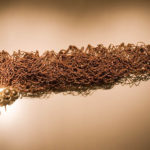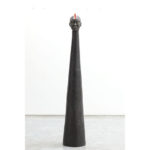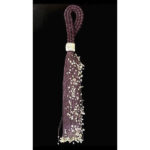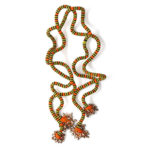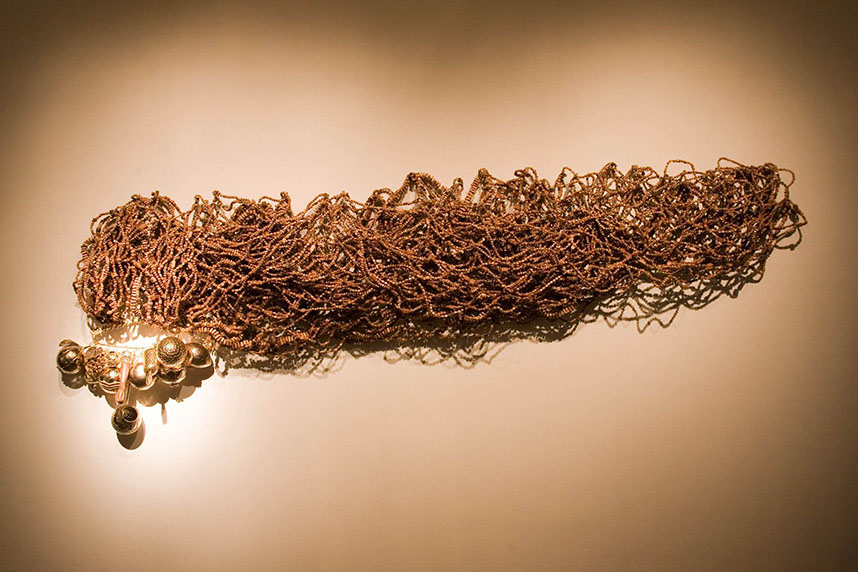They are sculptures, object-sculptures, art installations and video installations that reveal an artistic investigation of a poetics related to the history of Brazil, through a contemporary look at tradition, African heritage, ancestry before oppression and the hope for freedom.
They are sculptures, object-sculptures, art installations and video installations created with a mixture of demolition wood or from certified origin, gold, silver, beads, amulets, coconut mosaic tiles, conch shells, straw and beading present in several of them, among other materials, resulting in a thoroughly investigation of the African descent history in Brazil.
They are sculptures, object-sculptures, art installations and video installations that portray the Afro-Brazilian religious culture, its history and identity, from a colonial jewellery research, featuring the balangandãs from slave women. The artist started her journey as a sculptor from this encounter with the history of Bahia, from this ancestral knowledge. A close look at African jewels and body adornments, and that through a poetics and an aesthetic make up her creation and her own imaginary about the religiosity and the African descent citizenship.
Nadia Taquary is from Bahia, Brazil, born in Salvador. Graduated in Languages and Literature by UCSAL and postgraduate in Education, Aesthetics, Semiotics and Culture by EBA-UFBA. In 2011, she held her first individual exhibition called A Bahia Tem…, at the Museu Carlos Costa Pinto Museum. His work has already been presented at the MAR (Museu de Arte do Rio Museum, 2014), SPArte (2016), Arte Rio (2015), Museu de Arte da Bahia Museum (2014), 3rd Bienal da Bahia (2014) and at the Galerie Agnès Monplaisir (Paris, 2016). It is in the MAR (Museu de Arte do Rio) collection and is part of several private collections all over Brazil and abroad.
Your sculptures and objects, as I prefer to call them, is an artwork originated in the colonial period, having an Afro-Brazilian/Afro-Bahian history, a contemporary outlook on art, and it raises some questions:
What is your relation to the aesthetics and the poetics they carry, with the Afro-Bahian history, culture and popular imaginary?
My relationship is one of complete belonging to this Afro-Bahian culture, including everything it embraces regarding historicity, miscegenation and religiosity.
How do you perform the research for the transposition of adornments and jewels into sculptures and objects? What motivation led you to make jewels and adornments, utensils, beads and balangandãs, amulets, fish, nets and other objects the central element of your creation?
Afro-Brazilian jewelry has always attracted my attention because of its strong presence, strong aesthetics, rich, opulent, ostentatious, and for revealing in itself the meeting of two peoples where the Portuguese technique joins the African aesthetic, giving birth to a jewelry typically from Bahia. Talismans, amulets and objects denounce the syncretism and the mixed people we are.
My motivation is to draw attention to this Afro-Brazilian presence, which is incredibly essential in the construction of our history and the identity of who we are.
The dimensions of this transposition, from small to large, from 8 to 80 meters, and the material – wood, gold, silver, beads, ropes, coconut mosaic tiles, among others, stand out. In this transposition, do you find what you need for your contemporary vision, or are they just means for you to achieve your aesthetic purpose?
The size is a call to recognize ourselves in this story that not only speaks of the pains from slavery, it also talks about a strong heritage and origins, of overcoming, of becoming what we are. In this sense, the aesthetic purpose of enlarging it is to give voice to a cry about what you cannot hear nor see.
Your work, a fruit of research, does not attempt to reproduce, but to make a reinterpretation of that time instead. Talk a little about this look, what encourage you to perform this research and to what you do today. How do you feel this transformation? Does it achieve your goal or your desire?
Yes, it does not. The object has already been made, and reproducing it would not satisfy me, but appropriating these signs and symbols by inserting them into my creative process, taking them off its place of origin to tell the story through a personal point of view, that’s truly satisfying.
Does your creation scroll through tradition, the African heritage, the ancestry, to get the contemporary look from it? As you have said: “People have to take a good look at themselves and recognize the value of their ancestral culture.” This is performed through an aesthetical re-creation, a poethic investigation or our history. Is there a conscious starting point for the symbolic meanings from your creation?
The starting point would be the affective memory about my father, who not only possessed the so-called “African Women Jewelry” but also gave me them in several of my Birthdays during my childhood and adolescence. Therefore, performing this research is an encounter with history and, above all, an encounter with myself.
Your exhibitions are named with references to several aspects of Afro-Bahian culture. What is your relation to it? Its culture and history? Its aesthetics and symbols? Its religiosity?
My relation, since I’m from Bahia, is one of close identification with this culture in what I live, in what I dance, in what I eat, in what I see and in what I create.
As for religiosity, it is impossible to disassociate it from my art; there is nothing in the traditional African art that is devoid of religiosity, nor a single utensil, nor a mask, nor objects of daily use. Nothing is devoid of meaning, of symbols which speak of this religiosity. The art from which I take my inspiration has the function of connecting human and spirit. Àiyé and Òrun. I can’t create without consciously going through these places. A string of yellow beads is not just a string. During its construction, it is impossible to not reverence the sweet presence of Oshun and whisper: “Welcome, Ora ye ye o”.
Being a contemporary sculptural artwork, your exhibitions in museums are installations. Is this a natural consequence of the relation that is to be shown, turning the look of today over the tradition, is it essential for your process and creation, a natural complement to be able to present them in shows, or just a particular or current way of performing your art?
Not all of my work are installations, but the ones that are, it comes from necessity from the own creative process that it be like that. It is a personal necessity that in some works this aesthetic-visual format be fully experienced.
Do you see in your work an aesthetic commentary on time, tradition, the new, the current art? By the way, how do you see yourself in Bahian and Brazilian art today? And what is this art currently?
I see myself belonging to a group of artists who talk about issues related to the presence and importance of the black people in Brazil, which, although clearly explicit, are still unknown by many, if not denied. I am truly proud to resound in the midst of wonderful and outstanding colleagues whom I admire, and who in their work and speeches never stop talking about, as often as necessary, the strength and beauty in our heritage and history.
You have held exhibitions in museums and released your artwork in stores, today it is represented by Paulo Darzé. How does this trajectory in the professional circuit of Brazilian art feel? And also, how does it feel to be inserted in this circuit? What has changed?
I’m very relaxed at each step, each new stage my work has allowed me to experience. Belonging to an important gallery such as Paulo Darzé is of fundamental importance for my career as an artist and for the prospection of my work. With this wonderful partnership, I can think and create more freely, in a space where I dialogue with contemporary art at several different levels, where I can comfortably dig into the issues related to the poetics of my work, making it even more conscious worldwide.
It seems to me that you were born in Salvador, raised in Valença, studied Literature, Fine Arts, have graduate and postgraduate degrees. Can you talk a little about your biography and formation?
I was born in Salvador, I have spent my childhood and adolescence in Valença, returning to Salvador at age 17 to attend university. I got a graduate degree in Literature at UCSAL and a postgraduate degree in Art, Education, Aesthetics and Culture at UFBA. I went to Fine Arts to study African culture, art and education, from where I followed my own research on Afro-Brazilian jewelry and body adornments used by African peoples, constructing the poetics of my artwork through all this.
(Interview/May, 2017)


